Please sign in first
Not a member?
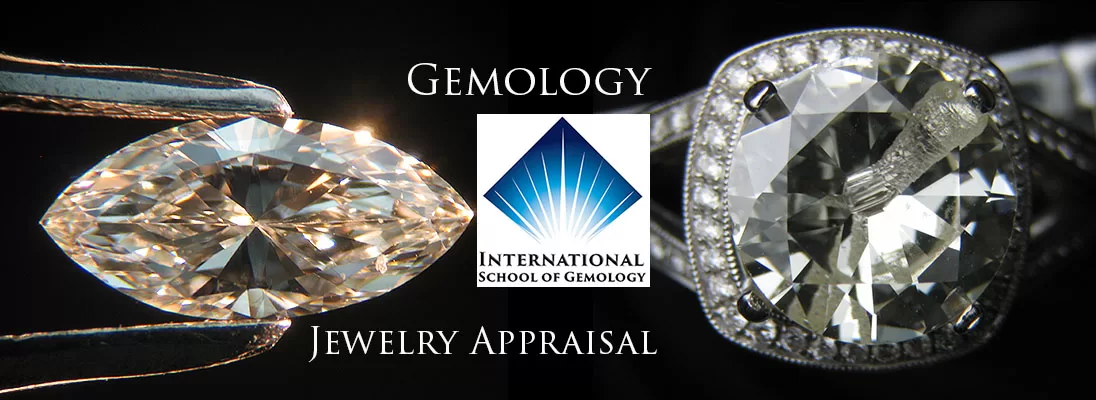
- Home
- Online Education Programs
- RG/RGA Legacy Entrance
- ISG Credentials
- Frequently Asked Questions
- Registry of Graduates
- Careers in Gemology
- Important Program Information
- Newsletters
- Identifying Lab Created Diamonds
- Black Diamond or Created Moissanite?
- Ebay, the GIA, and Section 230
- Lessons From the Angry Janitor
- Exposing the Truth about Lab-Created Diamonds
- AGTA Hobbles Dealers and Buyers
- Appraisers -v- Gem Labs…a Legal Imbalance!
- Understanding the Classification of Diamonds
- Cremation Diamonds: Insuring and Litigating
- Let’s Talk About Gemology Credentials
- Hometown Jewelers and the Force Majeure Clause
- Following the Critical Angle of Diamond Grading
- When Breitling Brought the Airmen Home
- Let’s Open a Refractometer
- Measuring the Energy of Light
- Quick Reference Guide to Sunstone
- ISG Seeing the Invisible Light
- Contact Us
Black Diamond or Created Moissanite?
Black Diamond or Created Moissanite?
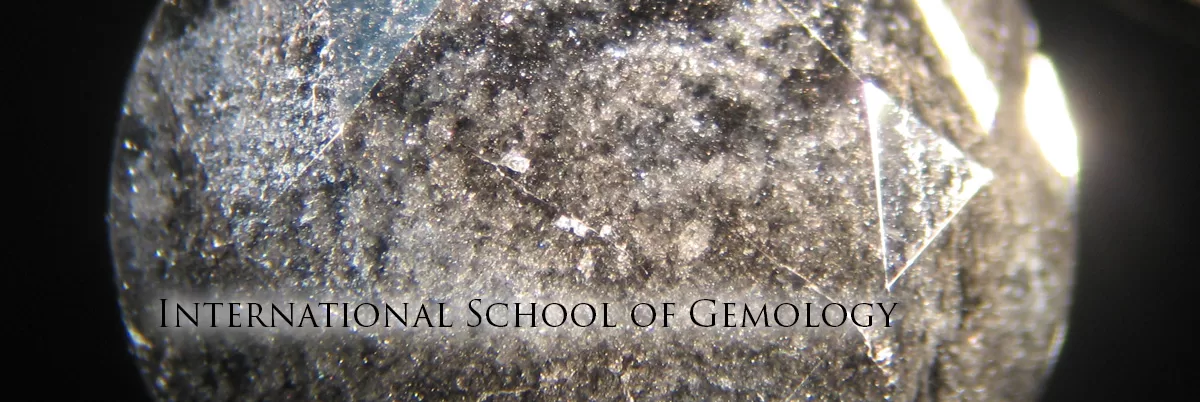
Black diamonds are among the hottest items in the jewelry market. Their very name conjures up dreams of exotic places and people. But what really is a “black diamond,” and how do you know you are getting a true black diamond and not an imitation like created black moissanite?
First, authentic natural black diamonds are rare. The conditions at which carbon crystallizes cause all of the carbon to crystallize. So, the concept that black diamonds are made of uncrystallized carbon is not totally accurate based on current scientific reports. Most black diamonds are low-quality diamonds that have been irradiated to create a very dark green color that appears black. Some are regular diamonds that are so heavily included that they appear black. Whatever the source, black diamonds are hot on the market, and many have asked how to separate black moissanite from black diamonds. Here are a few “tells” we have found that may be of assistance in the effort.
The first involves the sheer nature of the materials. As you can see below, irradiated black diamonds are made from low-quality diamond crystals. As a result of the low starting quality and perhaps what happens to these diamonds during the irradiation process, the diamonds are very grainy with light and dark colors throughout. As seen in the image below, surface-breaking fissures are easy to see.

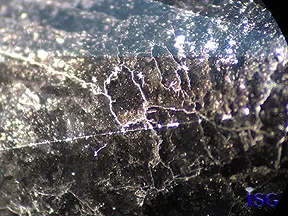
Created moissanite, however, is almost glass-like. The lab-created material is pristine and uniform, therefore presenting a far different look through magnification than most black diamonds. As seen below in overhead light reflected off the table surfaces, the created moissanite has a mirror-like surface, while the black diamond has a surface-reaching fissures and pits. This is your first “tell” to separate created moissanite from black diamond….the formation or structure of the stone itself.
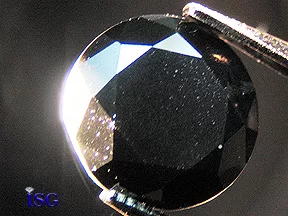
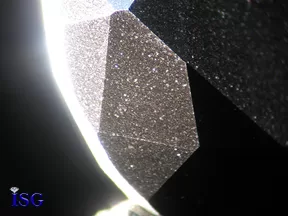
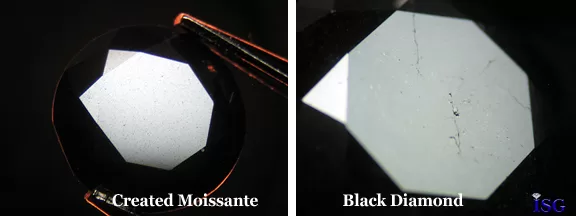
Presidium Reflectivity Meter
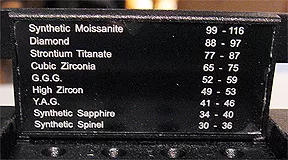 Although our Jemeter Digital 90 is our main tool for gemstones with refractive indices that are over the limit of the traditional refractometer, the Presidium Reflectivity Meter proved a diagnostic tool for separating created moissanite from black diamond. At left is the reading scale that flips up on the meter. You place the stone over the aperture of the meter and press the button. Instantly, this gizmo is able to diagnostically separate our black diamond from our black-created moissanite. Below are the actual readings of our black gemstones on the Presidium Reflectivity Meter.
Although our Jemeter Digital 90 is our main tool for gemstones with refractive indices that are over the limit of the traditional refractometer, the Presidium Reflectivity Meter proved a diagnostic tool for separating created moissanite from black diamond. At left is the reading scale that flips up on the meter. You place the stone over the aperture of the meter and press the button. Instantly, this gizmo is able to diagnostically separate our black diamond from our black-created moissanite. Below are the actual readings of our black gemstones on the Presidium Reflectivity Meter.
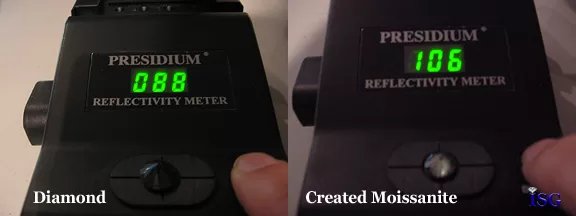
Jemeter Digital 90
The jewelry industry lost a huge opportunity to make gem identification easy when we failed to fully comprehend the value and usefulness of the Jemeter Digital 90, which has been out of production for many years now. This is also a reflectivity meter as the Presidium above but with the added value of a software interpretation of the readings that provide an actual refractive index reading. As you can see below, the Jemeter Digital 90 gave us virtually textbook readings for the refractive indices of these two gemstones. Another “tell” in the separation of black diamond from created black moissanite.
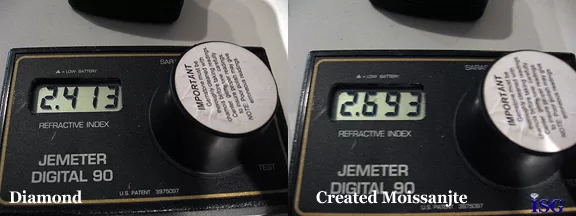
Raman Spectroscopy
Below are actual Raman scans of created moissanite, natural diamond, and irradiated diamond. The created moissanite is from the RRUFF files, and two diamond scans are from the ISG archives. As you can see, the difference in Raman peaks for the created moissanite is significantly different from that for the natural or irradiated diamond. This technology makes for easy separation of gemstones.

Below are Raman scans of the black moissanite and black diamond created in this newsletter. As you can see, the separation is quite easy using Raman Spectroscopy.
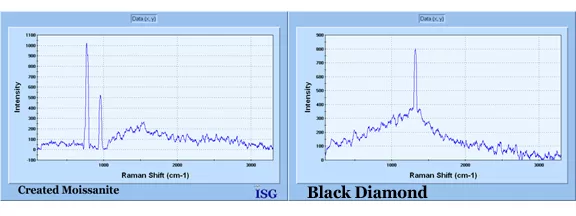
After reviewing many irradiated black diamonds and created black moissanite, it became clear that an experienced gemologist with a good microscope and fiber optic light can separate black diamond and created black moissanite simply on the structure, as seen at the top of this newsletter. However, for more in-depth verification, the Presidium Reflectivity Meter and Jemeter Digital 90 provide cost-effective diagnostic results. For those of you who would like to take advantage of the lower cost of Raman technology that has been designed for the jewelry and gemology industry, we strongly recommend the GL Gem Raman as this new technology has far greater applications than simply this subject. Given the affordable price and the technical support available from the Gemlab organization, there is every reason now to add this technology to your gemological lab or jewelry-buying office.
We should note that there are other black stones that emulate black diamonds, which will need to be covered in a follow-up report. For now, we hope this is of assistance to those who want to be sure they are dealing with authentic black diamonds and not created black moissanite when they make their purchase or sale.